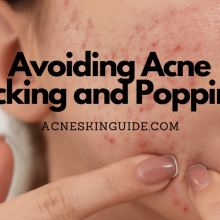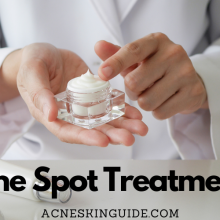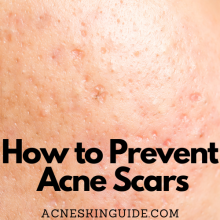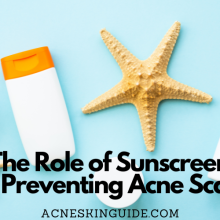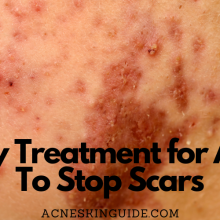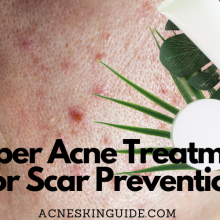At Home Acne Scar Prevention – Remedies and DIY Treatments | AcneSkinGuide
Summary of At Home Acne Scar Prevention
Acne scars can be frustrating reminders of previous blemishes, but there are many affordable at-home remedies that can help minimize their appearance and prevent new scarring. Common scar types include icepick, boxcar, and rolling scars caused by inflamed acne lesions damaging the skin. Natural ingredients like lemon, baking soda, aloe vera, honey, and apple cider vinegar can help fade discoloration and smooth textures when used consistently.
DIY face masks with turmeric, oatmeal, tomato and other kitchen staples provide rejuvenating treatments. Gentle exfoliation, moisturizing, sunscreen, and color-correcting makeup can also help camouflage and fade scars. For severe pitted scars, professional treatments may be needed. The key is being patient, consistent with at-home remedies, and using techniques like massage to achieve optimal scar minimization over time.
Our Top 5 Recommended Acne Treatment Products

At-Home Acne Scar Prevention: Affordable Remedies That Work
For those who have battled acne, the frustrating aftermath is often the scarring left behind. Acne scars can be depressing reminders of previous blemishes and make you feel self-conscious about your skin. While preventing acne is ideal, scars are sometimes unavoidable. The good news is there are many affordable at-home remedies that can help minimize the appearance of acne scars and prevent new ones from forming.
What Causes Acne Scars?
Before discussing treatments, it’s important to understand what causes acne scars in the first place. They occur when acne lesions become inflamed and break the follicle wall in the dermis layer of skin. As the acne clears, the body produces collagen to repair the damage, resulting in the raised or pitted areas on the skin known as scars.
Types of Acne Scars
The most common types include icepick scars (deep pitted scars), boxcar scars (broader pits with sharper edges), and rolling scars (broad depressions with sloping edges).
Risk Factors for Scarring
Several factors increase your risk of developing scars, such as picking or popping pimples, having inflammatory acne like cysts and nodules, genetics that make you predisposed to scarring, and having darker skin.
Early Scar Intervention
It’s important to identify acne scars early on when they often appear as red or brown discoloration, before textural changes like pits or raised tissue fully develop over time. Prompt treatment during this initial hyperpigmentation stage gives you the best chance of preventing permanent scarring.
Lifestyle Habits for Prevention
While you can’t control all scarring risk factors like genetics, some lifestyle habits can minimize development of new scars:
- Properly treat active acne breakouts to avoid more inflammation
- Never pick, pop or squeeze pimples which drives acne deeper
- Protect skin from sun exposure that worsens scarring
- Manage stress which aggravates inflammatory acne
- Follow a nutritious diet rich in antioxidants to aid healing
Focus on these preventative measures along with treatments for existing scars.
Natural Remedies for Acne Scars
Many affordable natural ingredients can help lighten discoloration, smooth textures, and rejuvenate skin to improve scar appearance over time when used consistently.
Lemon Juice Remedy
The citric acid and vitamin C in fresh lemon juice work as a gentle chemical peel to fade hyperpigmentation while vitamin C boosts collagen production.
Baking Soda Scrub
Baking soda has anti-inflammatory properties and provides gentle exfoliation when used as a face scrub, which smooths out rough raised scars.
Aloe Vera Gel
Aloe contains beneficial compounds like vitamin E and salicylic acid that treat scars while its cooling gel soothes inflammation.
Raw Honey Treatment
Honey is antibacterial, reduces inflammation, and boosts wound healing thanks to compounds like hydrogen peroxide. Manuka honey is especially potent.
Apple Cider Vinegar Toner
The acetic acid in ACV promotes skin regeneration, while fighting bacteria that worsen scarring. Use it as a toner.
Green Tea Compress
Polyphenol antioxidants in green tea have anti-inflammatory and antimicrobial properties that treat inflamed scars and calm redness.
Other Natural Options
Other useful natural ingredients include nourishing oils like rosehip seed, tamanu, and vitamin E as well as common kitchen staples like potato, cucumber, yogurt and oats. User proper recipes, leave masks on for 15-20 minutes and always do a patch test on a small area first to check for any irritation.
Potential Downsides
Some natural acids like lemon or ACV could be too harsh for very sensitive skin or aggravate inflammation initially. Stick to gentler options if this is the case.
DIY Scar Treatment Face Masks
In addition to single-ingredient remedies, you can whip up simple face masks at home using a few affordable items. These provide invigorating mini-facials to fade acne scar discoloration and soften rough texture:
Turmeric Face Mask
Mix one teaspoon turmeric powder with equal parts honey and either lemon juice or milk. This traditional Indian remedy treats hyperpigmentation and inflammation.
Oatmeal Face Scrub
Blend one cup oats into a powder and mix with water to form a gritty paste that gently polishes away acne scars without irritating skin. Add a squeeze of honey.
Tomato Face Pack
This tangy face pack brightens and lightens scars thanks to the lycopene and vitamin C in tomato puree. Mix with lemon, sugar and fuller’s earth powder.
Other DIY Options
Other popular DIY scar treatments include yogurt masks, papaya or pumpkin puree masks, coconut oil massage, and baking soda/lemon scrubs.
Gentle Application Reminder
Just be cautious about over-scrubbing very textured scars.
Potential Downsides
Scrubs could potentially worsen inflamed or indented scars so proceed gently. Acidic ingredients may sting sensitive skin. Patch testing is advised.
Concealing and Fading Appearance
Even shallow scarring or hyperpigmentation left behind can leave skin looking rough and uneven. Use a few cosmetic camouflage techniques to temporarily disguise scars while you treat them:
Gentle Exfoliation
Gently exfoliate 1-2 times per week to buff away dead skin cells and smooth textures.
Moisturize Daily
Use a quality fragrance-free moisturizer to hydrate and plump skin, making scars look less pronounced.
Use Sunscreen
Always wear sunscreen as UV exposure darkens discoloration and damages healing skin.
Color Correcting Makeup
Color correcting makeup products like green-tinted primers can neutralize redness around inflamed scars.
Concealing Techniques
Certain makeup application techniques like using a damp beauty sponge can help camouflage and smooth over textured scars.
When to See a Dermatologist
For severe pitted scars or those that don’t improve with home treatments, see a dermatologist. Professional procedures like lasers, chemical peels, dermabrasion, fillers, and surgery may then be recommended to improve stubborn scars.
Be Patient and Consistent
Be patient and consistent with at-home acne scar prevention and treatment. Combine remedies and techniques for optimal results. While perfection is impossible, these affordable methods can minimize scarring over time.
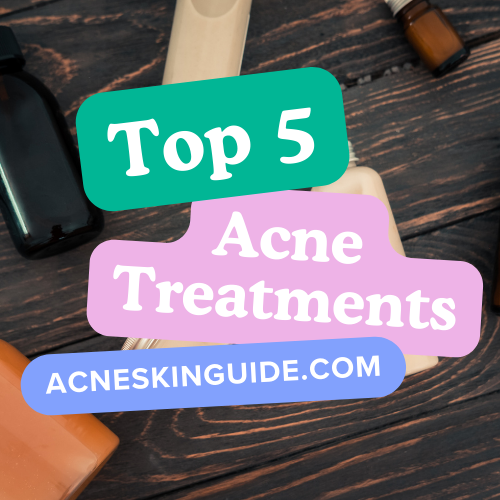
Our Top 5 Recommended Acne Treatment Products
Struggling with stubborn acne? Don’t wait any longer! Discover the top 5 best acne spot treatments reviewed by acne experts. From fast-acting overnight formulas to potent systems that clear acne from within, find your solution now. Unveil clearer, blemish-free skin with our expert guidance. Click here to read the in-depth reviews!
FAQs and Answers
How long does it typically take to see results from home acne scar treatments?
The amount of time it takes to see results from home acne scar treatments can vary quite a bit depending on several factors:
Severity of Scarring – Shallow, newer scars may start fading in 4-8 weeks with consistent treatment, while deeper, older scars can take 3-6 months or longer to see noticeable improvement.
Type of Scar – Treatments tend to work faster on hyperpigmentation and discoloration compared to textured, pitted scars which take more time to smooth out.
Consistency of Treatment – Using remedies once or twice won’t make much difference. You need to apply them daily or several times per week over months.
Individual Healing Rate – Some people’s skin naturally rejuvenates and produces new collagen faster than others based on age, genetics, etc.
In general, you may start seeing minor fading of red/brown acne marks in 4-8 weeks. More significant softening of raised scars and textural changes can take 2-4 months. Complete scar removal is very difficult without professional treatments. The key is being diligent and patient – visible results take at least 8-12 weeks for most people using home remedies alone. Progress can be gradual but consistent care is crucial.
Are there any contraindications or risks to using certain home remedies?
Yes, there are some potential contraindications and risks to be aware of when using certain home remedies for acne scar treatment:
Allergic Reactions
Many natural ingredients like lemon, baking soda, honey etc. can potentially cause allergic reactions in some people, especially when used on the sensitive facial area. It’s important to do a patch test first before applying anything new to your face.
Skin Irritation
Ingredients with high acidity levels like lemon juice, apple cider vinegar, or harsh exfoliants may irritate the skin if used too frequently or left on too long, especially on inflamed acne scars. This can lead to redness, stinging, and potentially more scarring.
Photosensitivity
Some remedies containing alpha hydroxy acids or other botanical extracts can increase photosensitivity, making skin more prone to sunburns. Be diligent about sun protection when using these.
Internal Toxicity
While safe in small amounts, ingesting large quantities of certain home remedies like baking soda could potentially cause toxicity issues or interactions with medications.
Open Wounds
Applying home treatments to open acne lesions or severely inflamed cystic acne runs the risk of infection and worsening scarring. Wait until active acne is mostly cleared first.
Overall, home remedies are generally safe when used properly diluted/prepared and for short durations. But those with very sensitive skin, certain medical conditions, or who are pregnant/breastfeeding should consult their dermatologist before trying new substances, especially potentially irritating ones. Moderation and patch testing is key.
Can home treatments help with different types of acne scarring equally?
No, home treatments are not equally effective for all types of acne scarring. The degree of improvement you can expect depends on the specific scar type:
Hyperpigmentation/Discoloration
Home remedies containing ingredients like lemon, baking soda, turmeric, and vitamin C can be very helpful for fading red/brown acne marks and evening out skin tone. These are among the easiest types of “scars” to treat at home.
Raised/Hypertrophic Scars
For raised, thick scars, natural oils like rosehip seed oil combined with regular gentle massage can help flatten and soften the dense collagen over time. However, significant improvement is difficult without professional treatments.
Atrophic/Pitted Scars
Depressed, pitted scars like boxcar and icepick scars are the most challenging to treat at home. While exfoliation and collagen-boosting ingredients may yield minor improvements, deeply indented scars are very resistant to filling in completely with just home care.
Rolling Scars
These wave-like, tethered scars can sometimes be released and smoothed out slightly with consistent acne scar massage using oils. But significant textural changes are difficult.
Overall, hyperpigmentation and shallow raised scars tend to respond best to at-home treatments over time. Depressed atrophic scarring is much harder to treat substantially without professional procedures like lasers, dermabrasion, fillers etc. Realistic expectations are important when treating scars at home.
How can you tell if an at-home treatment is actually working or not?
Here are some ways to evaluate if an at-home acne scar treatment is working effectively or not:
Before and After Photos
Take close-up photos in the same lighting conditions before starting a new treatment. Then take comparison photos every 4-8 weeks. Visible fading of discoloration or textural changes indicate it’s working.
Use a Bright Light
Examining your scars closely under a bright light can help detect subtle improvements. Look for reduced redness, smoother surfaces, and softer edges around indentations over time.
Feel the Texture
Gently run your fingers across scars – improvement will be evident if raised scars start flattening out and indented areas become more filled in and less grooved feeling.
Try the Makeup Test
If makeup starts going on more smoothly without accentuating scar grooves or depressions as much, that’s a good sign the surface texture is improving.
Track Hyperpigmentation
For colored acne marks, use a green-tinted color correcting concealer. As the marks fade, you’ll be able to use less green concealer needed underneath regular makeup.
Make a Scar Map
In the beginning, use a face mapping technique – outline the borders of darker marks/indentations. Then check if those areas are lightening or shrinking over time.
If you don’t notice any changes in appearance, texture, or coloration after 2-3 months of diligent use, it may be time to switch treatments. Stick with what’s working slowly but surely.
What role does microneedling or dermarolling play in at-home scar revision?
Microneedling or dermarolling can play a helpful supporting role when used alongside other at-home acne scar treatments. Here’s how it can potentially benefit scar revision:
Enhances Product Penetration
The tiny needles create thousands of microscopic channels in the skin, allowing active ingredients from serums, oils, and masks to penetrate much deeper into the scar tissue. This amplifies their effects.
Stimulates Collagen Production
The micro-injuries caused by the needle rolls trick the skin into proliferating collagen and elastin production to heal itself. This new collagen can help fill in depressed acne scars.
Breaks Up Scar Tissue
Rolling over thick, raised hypertrophic scars with the needles can help break up the dense collagen bands and smooth out the surface texture.
Improves Product Absorption
Dermarolling creates better permeability in the skin for up to 48 hours, allowing nutrients and actives from at-home scar treatments to absorb more effectively.
Should Be Used Carefully
Proper sterilization and technique is crucial to avoid infection or further skin damage. Going too deep can potentially worsen scarring. Start with shorter 0.25-0.5mm needles.
Microneedling should be viewed as a complementary technique, not a complete solution. It works best for preparing skin to better respond to topical at-home remedies. Regular dermarolling may modestly improve some acne scars, but severe pitting usually requires professional microneedling RF or laser treatments.

Our Top 5 Recommended Acne Treatment Products
Struggling with stubborn acne? Don’t wait any longer! Discover the top 5 best acne spot treatments reviewed by acne experts. From fast-acting overnight formulas to potent systems that clear acne from within, find your solution now. Unveil clearer, blemish-free skin with our expert guidance. Click here to read the in-depth reviews!

